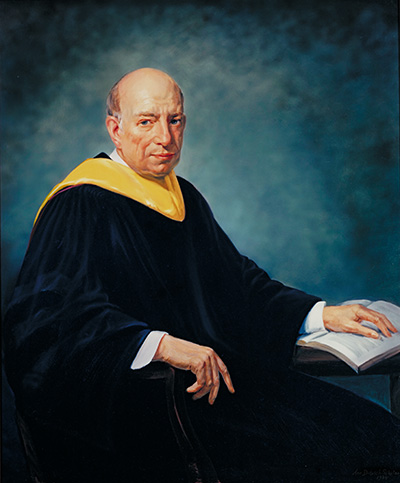Arnall Patz

Arnall Patz
- Artist:
- Ann Didusch Schuler
- Date:
- 1984
- Medium:
- Oil on canvas
- Dimensions:
- 39.5 x 32 in.
Arnall Patz
1920-2010
Patz, a director of the Wilmer Eye Institute, was born in Elberton, Georgia. He received a B.S. in 1942 and an M.D. in 1945 from Emory University. Patz entered the General Duty and Residency Program at Walter Reed Army Medical Center, and in 1948 was discharged with the rank of captain. He then began a residency in ophthalmology at Gallinger Municipal Hospital, later known as District of Columbia General Hospital.
During his residency, he observed more than twenty infants who had developed severe retrolental fibroplasia (now known as retinopathy of prematurity) after receiving continuous oxygen therapy. As an epidemic of blindness among premature babies in the 1940s and the early 1950s was perplexing physicians, Patz hypothesized that there was a correlation between the high rate of blindness and the use of pure oxygen to treat premature babies.
He proposed a clinical study to test his hypothesis, but found it difficult to obtain grant funding. Patz borrowed money from his family to conduct a clinical study with Leroy Hoeck, a pediatrician who was in charge of the newborn nursery at Gallinger, in which some infants were given concentrated oxygen, and others were given concentrated oxygen only if they showed signs of respiratory distress. His study determined that elevated oxygen levels caused abnormal growth of blood vessels in the eye, irreversibly damaging the retina. As a result of these findings, the use of high-dose oxygen therapy was limited, and there was a sixty percent reduction in childhood blindness in the United States. Patz was recognized for this breakthrough with the Albert Lasker Research Award in 1956.
Patz moved to Baltimore and opened a private ophthalmology practice in the 1950s. He joined the part-time faculty of the Johns Hopkins University School of Medicine, Department of Ophthalmology, in 1955. He also worked with the Johns Hopkins University Applied Physics Laboratory to develop an argon laser to treat retinal eye disorders in 1968. Such lasers are now standard treatment for macular degeneration and for eye disorders occurring with diabetes.
In 1970, he joined the full-time faculty of the Johns Hopkins University School of Medicine as an associate professor in ophthalmology, where he founded the Retinal Vascular Center and continued his research in laser therapy. Patz was named the William Holland Wilmer Professor of Ophthalmology and Director of the Wilmer Eye Institute in 1979. He became professor emeritus and director emeritus in 1989.
Patz received many other awards for his contributions to science and ophthalmology, including The Jules Stein Award for Outstanding Ophthalmic Achievement in 1983, and the Presidential Medal of Freedom in 2004.
"*" indicates required fields
